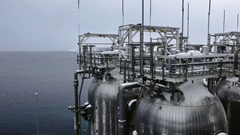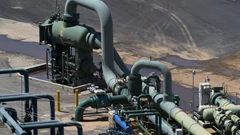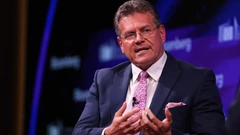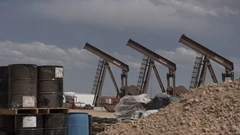Germany Faces $1 Trillion Challenge to Plug Massive Power Gap
(Bloomberg) --
Germany has set aside more than €260 billion ($275 billion) to deal with the immediate risks of an energy crisis triggered by Russia’s war in Ukraine, but the ultimate fix will be much costlier — if the country can pull it off at all.
The pending price tag for future-proofing the country’s energy system is projected to amount to over $1 trillion by 2030, according to BloombergNEF. The costs include investments in upgrading power grids and above all new generation to manage the phase out of nuclear and coal plants, handle increased demand from electric cars and heating systems, and meet climate commitments.

The transition will require the installation of solar panels covering the equivalent of 43 soccer fields and 1,600 heat pumps every day. It also needs 27 new onshore and four offshore wind plants to be built per week, according to a wish list presented by Chancellor Olaf Scholz during a recent visit to Volkswagen AG’s headquarters in Wolfsburg.
“This is a bold undertaking — possibly the boldest project since the reconstruction of Germany,” Vice Chancellor Robert Habeck, who oversees climate and energy policy, said earlier this month.

Around 250 gigawatts of new capacity will have to be installed by 2030 — when power demand is expected to be about a third higher than it is now — according to estimates from Germany’s network regulator and think tank Agora Energiewende.
To put the scale of the challenge in context, the required generation is enough to cover current household demand for all 448 million people in the European Union. The additions will be a mix of renewables and gas-fired plants — that might one day be converted to run on hydrogen.
It will be a long road to get there. This week, the government announced it will prepare tenders this year for gas plants that account for about a tenth of that capacity. And for renewable expansion, setting up a single wind mast can takes as long as seven years to clear Germany’s red tape.
BASF SE’s plans to cut 2,600 jobs as it faces strains from the energy crisis is a sign of the urgency. The chemical giant’s operations in Germany swung to a loss during the second half, and it’s now closing a number of energy-intensive factories, including two ammonia plants and related fertilizer facilities, resulting in 700 job cuts at its main Ludwigshafen site.
“High energy prices are now putting an additional burden on profitability and competitiveness in Europe,” Chief Executive Officer Martin Brudermueller said. He also cited “overregulation, slow and bureaucratic permitting processes.”
At the heart of Germany’s dilemma lies political plans to phase out certain energy sources without clearly setting out the path to replace them. The country’s last three nuclear power plants will shut by mid-April, and it now aims to accelerate its exit from coal to 2030. The challenge has been intensified after Russia — Germany’s main energy supplier before the war — curtailed gas flows.
With nuclear and coal off the table, Germany has undertaken a rapid rollout of terminals for importing more expensive liquefied natural gas as it seeks to ensure it has the energy to power its industry-heavy economy. At the same time, electric cars, heat pumps and electrolyzers for producing hydrogen are set to raise demand by 33% to around 750 terawatt-hours by 2030, according to government estimates.
While Scholz and Habeck have shown there’s political will to push ahead with the transition, they need help from the private sector, including sourcing the tons of steel and other materials required for such a massive undertaking, according to Lisa Fischer, an energy-systems expert at think tank E3G.

Germany also needs to figure out how it will generate electricity when wind and sun aren’t available. The government’s plan so far involves readying a fleet of new gas plants that can later run on hydrogen, though it’s struggling to find investors willing to take on such costly projects.
“Under the current framework conditions, sufficient investment cannot be expected,” said Veronika Grimm, a member of an economic council that advises the government. The lack of funding comes from the high level of uncertainty in energy markets and unclear regulations, she added.
Doubling the Grid
Berlin is trying to solve the issue with a thorough revamp of how power is bought and sold, and a panel of experts advising the government on the redesign began deliberations this week. One option involves the establishment of so-called “capacity markets,” which already exist in the UK and pay producers for availability rather than just output.

The goal is to provide incentives for hydrogen-ready gas plants, even if they’re unlikely to receive much revenue outside of dark, still winter periods when renewable production is low.
Another challenge is ensuring green electricity, which is often generated in rural coastal regions in the north, can get to consumers and factories in the south. The size of Germany’s grid will have to double by 2030, according to Leonhard Birnbaum, chief executive officer of utility EON SE, which runs about 800,000 kilometers (500,000 miles) of Germany’s distribution network.
Despite all the challenges, Europe’s largest economy still has some time to work out the kinks and get the right conditions in place, but it needs to get moving.
“Germany can do it, but there are bottlenecks that at the moment aren’t being looked at in enough detail,” said E3G’s Fischer.
--With assistance from , and .
More stories like this are available on bloomberg.com
©2023 Bloomberg L.P.
KEEPING THE ENERGY INDUSTRY CONNECTED
Subscribe to our newsletter and get the best of Energy Connects directly to your inbox each week.
By subscribing, you agree to the processing of your personal data by dmg events as described in the Privacy Policy.
More gas & LNG news

ADNOC successfully completes $2.84 billion marketed offering of ADNOC Gas shares

Scientists Say EU Carbon Market Should Include Removals Like CCS

Trump Will Allow for More Gas Pipe Expansion, Southern CEO Says

EU Trade Chief Says Ready to Work With US on Lower Tariffs

EU to Look at More ‘Flexible’ Filling of Gas Storage Post-2025

bp begins production from Raven Phase 2, offshore Egypt

Diamondback Nears Permian Deal to Buy Shale Producer Double Eagle

Australia’s Iron Ore Hub Reopens, Rio Mines Resume After Cyclone

Australia’s Iron Ore Export Hub to Reopen After Cyclone Weakens
















